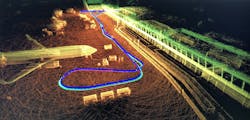Autonomous vehicles in the airside environment have the potential to enhance ground handling efficiencies. But in order to encourage the adoption of autonomous solutions, like the Auto-Dolly ULD baggage trailer, officials at Aurrigo set out to build a business case highlighting the benefits of autonomy.
In 2021, Aurrigo deployed its Auto-Sim software solution, which is capable of simulating current and future ground support equipment (GSE) operations.
“Auto-Sim was born out of Aurrigo’s prototype Auto-Dolly deployment at Heathrow Airport in 2019,” explains Sam Layton, lead software simulation engineer at Aurrigo.
“As such, Auto-Sim initially modeled autonomous and manual baggage fleets to highlight the automation benefits,” he continues. “It has since grown to encompass the complete airside operation, providing site-wide operational insight.”
Auto-Sim utilizes input data on the airside environment, resources, procedures and flight demand, Layton explains. The software then simulates the corresponding actions in detail.
“Every event that occurs can be reviewed, providing complete visibility of the activity. The data is filtered into targeted metrics, measuring success against key performance indicators, allowing the success of the simulation to be immediately understood,” Layton adds, noting airports, ground service providers and equipment manufacturers all stand to gain from the use of autonomous equipment.
Stakeholders have been involved from the inception of Auto-Sim in 2019, and have provided guidance in the development of Aurrigo’s feature set, ensuring it aligns with the needs and constraints of the aviation industry. Deployed in 2021, Layton says performance metrics and baggage-specific procedures have been tweaked to match the processes of Aurrigo’s clients.
“The standout feature of Auto-Sim is the replication of the client’s airside environment as a digital twin, encompassing an at-scale digital copy of the airside operating area. We engage with clients to collect material at all stages of the build process; from airside maps and driving rules to operating procedures, vehicle fleet composition and staff rosters,” Layton says.
“This ensures that the simulation is as accurate as possible.”
With the model built, simulation scenarios, along with variations, can be performed.
“For example, a client may wish to start by comparing a baseline scenario against an alternative with minor changes such as delayed flights or road closures,” Layton points out. “Alternatively, the same baseline could be compared against high impact changes such as new stand infrastructure or an autonomized fleet.
“Each simulation outputs extensive diagnostics data, which can then be filtered into quality-of-service metrics, providing instant measures of success.”
Comparing data across baseline and diverging scenarios, provides a user with statistical evidence for proposals that are otherwise difficult to produce supporting data for, Layton explains.
“The statistics could be used to justify an expansion plan, noting the performance improvement, or criticize it, noting a performance inefficiency if the current plan is not adjusted,” he says.
Auto-Sim is customizable software, which provides flexibility for each specific user. The core product offers performance benchmarking of a location’s current operation, but Layton says Aurrigo encourages clients to consider any future expansion.
“The output is most valuable with comparison between present and future scenarios – which, due to the scale of infrastructure or fleet changes, are often impossible to emulate in real life or with real-time capture software,” Layton says.
Auto-Sim is offered as both a consultancy-based solution and a hosted solution. Aurrigo simulates scenarios on behalf of a client that selects the consultancy approach. Conversely, with the hosted solution, a client receives the model and can simulate independently. This allows the client to choose their level of engagement.
“As a tailored software solution, Aurrigo provides optional enhancements that suit the individual client,” Layton says. “For example, this could include modeling of regional weather, airport-specific risk mitigation measures or differing baggage or cargo handling strategies that set them apart from other locations,” Layton says. “This allows Auto-Sim to provide customized results that are above and beyond what an off-the-shelf product can offer.”
Continued Enhancements
Auto-Sim is under active development with a growing team focused on enhancing the solution, Layton says.
“Operational improvements built for one deployment are, where possible, shared with the core software, offering frequent capability upgrades for new and existing clients alike,” he says.
Currently, Aurrigo officials are working on an expansive update aimed at overhauling the tools used to both build and visualize virtual airside environments
“This will not only streamline the environment building process, but will also allow users to spot operational inefficiencies by playing back the activity as it happened,” Layton explains.
The software’s ability to capture and compare baseline and future scenarios offers benefits to the industry.
“With this approach, the client can save money through the use of more efficient procedures today, and then apply these adjusted procedures to a model of their future plans to see how well they will stack up in the future,” Layton says. “The result is that the software allows the client to not only make cheap, cost-effective savings in the short term, but also empowers them to consider more expensive solutions with longer payoffs.”
As an autonomous vehicle manufacturer, Aurrigo can also provide autonomous vehicle simulations without the need for third-party consulting.
After the initial version of Aurrigo’s simulation software was trialed at London Heathrow Airport as a component of the Auto-Dolly deployment in 2019, the company’s principal partner has been a prominent Southeast Asian transport hub, where the product has been used for the comparison of manual and autonomous scenarios within the context of a new terminal build, according to Layton.
“Following our launch, we have been dipping our toes into other international markets and have just signed on with Gerald R. Ford Airport in Michigan to model their current operations (including snow mitigation methods) against future expansion and operational changes,” Layton says.
Layton says feedback has been positive, noting continual feedback has been vital in understanding the airside landscape and ensuring procedures are in line with industry expectations.
When selecting a simulation solution, Layton encourages users to understand the scale and depth of the simulation, the nature of the scenarios to be simulated (if multiple are available) and the available output options.
“One often overlooked benefit of simulation is its capability over the long term. A chosen solution should have the adaptability to not only provide value today but continue to provide statistical guidance through the incorporation of environment or procedural changes within the software model,” Layton says. “This way, the output remains up to date and can continue to inform policy long after the initial deployment.”
About the Author
Josh Smith
Editor
Josh Smith served as editor of Ground Support Worldwide as editor from 2016 through 2024. He oversaw production of the print magazine, created GSW's newsletters on a daily basis, and updated the latest news on AviationPros.com.

